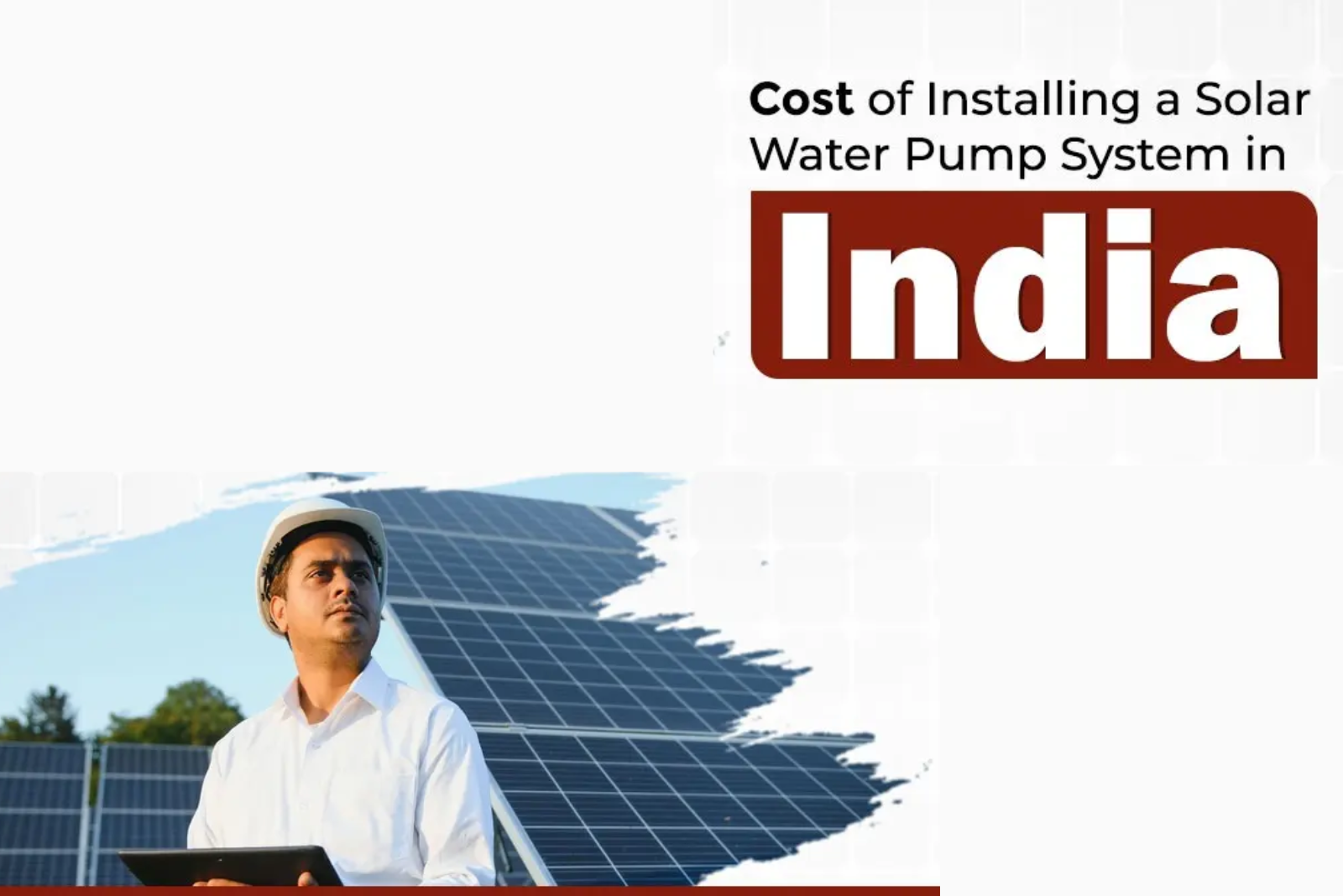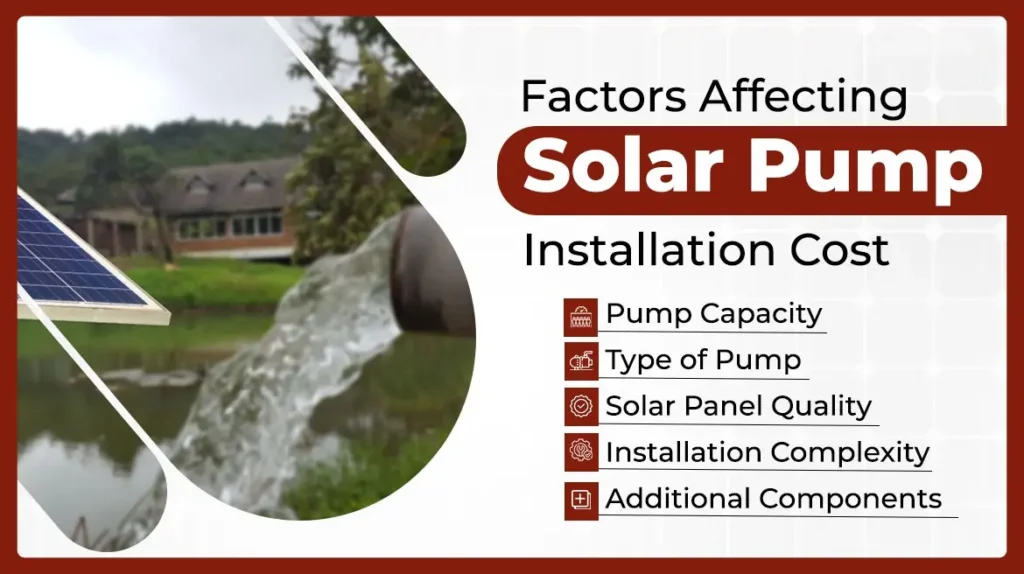Cost of Installing a Solar Water Pump System in India
- Home
- Blogs

Farming in India is seeing a huge shift as solar power is leading the way. The electricity costs are rising, and power cuts are still common in rural areas. This is why many farmers are turning to the solar water pump for agriculture. Why? Because it’s clean, efficient and a cost-effective way to water your fields.
But the question is, what does it cost to install one? In this blog, we’ll understand solar water pump costs and subsidies. This will help you understand if solar water pumps are the right fit for the agricultural sector in India.
What is the Price of a Solar Water Pump in India?
Pump Capacity | Approx. Price |
1 HP | ₹70,000 – ₹1,00,000 |
2 HP | ₹1,30,000 – ₹1,80,000 |
3 HP | ₹1,60,000 – ₹2,20,000 |
5 HP | ₹2,30,000 – ₹2,90,000 |
10 HP | ₹5,00,000 – ₹6,10,000 |
Factors Affecting Solar Pump Installation Cost

It’s not just about purchasing a pump. The cost of installing a solar water pump for agriculture depends on a number of factors. Let’s take a look at them.
1. Pump Capacity
The size of the pump is the main deciding factor for the cost. A higher horsepower (HP) pump draws more water, which makes it great for large farms and deep water sources. A powerful pump will have a high price. For example, a 10 HP system will have a higher cost than a 1 HP pump.
2. Type of Pump
There are different types of pumps that you’ll find in the market.
Submersible pumps – These pumps go under the water level and are best for borewells and deep wells. These pumps are on the expensive side due to their build and high power needs.
Surface pumps – Surface pumps are installed above the ground to fetch water from shallow water sources. These pumps are more affordable than the submersible ones.
Also read – Different types of solar water pumps
3. Solar Panel Quality
The solar water pump price depends on the quality of the solar panel too. There are many different types of panels with different efficiencies. The higher-quality panels’ price can be a bit high. These are more reliable and cost-effective in the long run.
4. Installation Complexity
Setting up a solar water pumping system requires labour, strong mounting structures and more wiring. All of this adds to the total cost which may affect the solar water pump price.
5. Additional Components
A solar water pump system isn’t just a pump and panels. It includes other parts too.
Inverter – It’s needed for an AC pump which cannot use direct current.
Controller – This manages the flow of current and also prevents damage.
Mounting structures – These hold your solar panels in place to maintain their efficiency.
Batteries – Batteries store extra energy so that the pump can work even in cases of no sunlight or at night.
Each of the factors matters in making up the total cost of a solar water pump. So, it’s important to consider every aspect while making a decision.
Government Subsidies for Solar Water Pumps in India
The Government of India has always been first when it comes to encouraging people to take steps for the betterment of the future. Solar water pump subsidy is one method to do so. By providing excellent subsidies for installing solar water pump for agriculture, it’s becoming increasingly easier for farmers to turn to solar.
Under their Pradhan Mantri Kisan Urja Suraksha evam Utthaan Mahabhiyan (PM KUSUM) scheme, the solar water pump subsidy is:
- Central Government Subsidy: 30% of the total cost.
- State Government Subsidy: 30% of the total cost.
- Farmer’s Contribution: The remaining 40% is borne by the farmer. (30% of which can be taken as a loan)
This means solar water pumps for agriculture have become easily accessible through subsidies and low solar water pump price.
Also read – Solar Kusum-B yojana & Solar Kusum-C Yojana for more information about the same.
Cost Difference: AC vs. DC Solar Pumps
- AC Pumps – These have a lower initial pump cost. However, these solar pumps require inverters to function which adds to the installation costs. Also, due to the complex components, the maintenance needs may rise and cause a rise in the expenses.
- DC Pumps – These pumps have a higher upfront cost due to many components. However, unlike AC pumps, these have low maintenance and operating costs since they run on solar power without the need for a utility grid.
Is a Solar Water Pump System Worth the Investment?
There are many uses of solar water pumps in agriculture. But the question is whether a solar water pump for agriculture is truly worth your money. Our answer is, yes, it is. Here’s why:
1. No More High Electricity Bills
As solar panels use sunlight, your solar water pump for agriculture won’t need to rely on the electricity grid. This reduces the electricity bills to a great extent. As farmers continue using solar water pumps for agriculture, they will be saving a lot in the upcoming years.
2. A Win for the Environment
Solar power is wonderful for the environment. Since the sun is a natural and renewable resource, it will minimise reliance on non-renewable energy resources. Burning coal and other fuels emits greenhouse gases such as carbon dioxide into the environment. That is why going solar is an intelligent and environmentally friendly alternative!
3. Lower Running and Maintenance Costs
The amazingness of solar panels doesn’t end at just their eco-friendly and efficient attributes, there’s much more. Once farmers install these solar pumps, they’ll have to face low maintenance costs. With no fuel and fewer moving parts, the maintenance is very affordable.
Check out – Maintenance and durability of solar water pumps
4. Strong Government Support
The government supports farmers through various initiatives and a solar water pump subsidy. This lifts the financial burden off of farmers and encourages them to make use of the amazing solar power to water their fields.
5. Long-Term Value for Your Farm
The Solar water pump for agriculture is not only cost-effective but also sustainable in the long run. The solar panels will run the water pumps to draw water every single day without degrading the environment.
Installation and Maintenance Charges Explained
Installing a solar water pumping system involves several steps:
Site Assessment: Evaluating the water source, land terrain, and sunlight exposure.
System Design: Determining the appropriate pump capacity and number of solar panels.
Installation: Setting up the pump, solar panels, and electrical connections.
Testing and Commissioning: Ensuring the system operates efficiently.
Maintenance costs include:
Regular Cleaning: Keeping solar panels free from dust and debris.
Annual Servicing: Checking pump performance and replacing worn-out parts.
Battery Maintenance (if used): Checking electrolyte levels, cleaning terminals, and ensuring proper charging cycles.
Also read – Solar AMC vs. One-time solar service
Conclusion
Installing a solar water pump for agriculture in India is a forward-thinking decision that aligns with both economic and environmental goals. Solar companies like KLK Ventures are making solar water systems accessible to farmers. The support of government incentives and long-term benefits all add up to make a perfect opportunity for farmers.
FAQs
What is the subsidy for a solar water pump?
Under PM KUSUM, farmers get a subsidy on solar water pump installation up to 60% of the costs.
How many solar panels should I use for a water pump?
It all depends on the capacity of the solar water pump. For example, a 1 HP pump may need 1.5 to 2 kW of solar panels to function well.
Is a solar water pump worth it?
Yes, of course it is. Farmers get great subsidies, low maintenance and operating costs. Apart from all this, the environmental benefits and sustainability are other things to consider.
